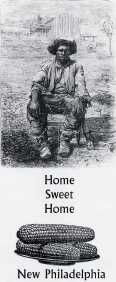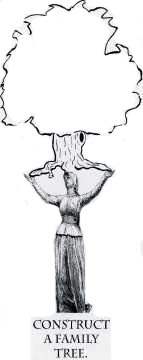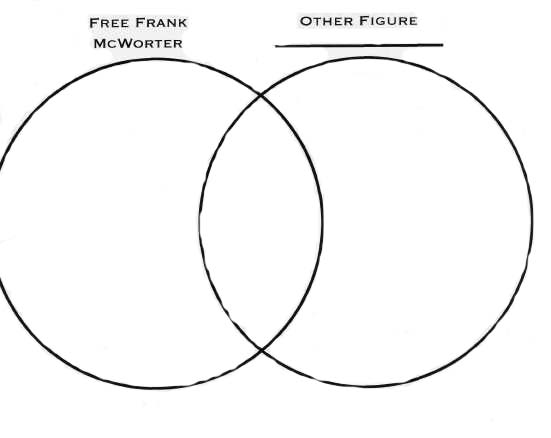 |
Home | Search | Browse | About IPO | Staff | Links |
 |
Home | Search | Browse | About IPO | Staff | Links |
Juliet E. K. Walker Free Frank McWorter (1777-1854), an African American pioneer and frontier entrepreneur who was born a slave and who purchased his freedom, has the historic distinction of being the first African American to found a town. In 1836 Free Frank legally platted and established the town of New Philadelphia on the Illinois frontier. Free Frank McWorter was also an entrepreneur, and his business activities offer a new frame of reference for our understanding not only African American participation in the development of America's frontiers but also of the history of blacks who established businesses. As a pioneer, Free Frank played an active role in the development of three frontiers—South Carolina, Kentucky and Illinois—as the new nation moved westward in the era between the Revolutionary War and the Civil War. Most significantly, with the profits earned from a variety of business activities, Free Frank, over a period of forty years purchased from slavery 15 family members at a cost of some $15,000. Free Frank was born a slave in Union County, South Carolina. In 1777, ironically, just one year after the 1776 Declaration of Independence was signed which stated that. "We hold these truths to be self-evident, that all men are created equal, that they are endowed by their Creator with certain unalienable Rights, that among these are Life, Liberty and the pursuit of Happiness." Free Frank's mother was the West African-born Juda; his father was slave owner Scotch-Irish George McWhorter. In 1795, when Free Frank was eighteen years old, his owner-father moved to Kentucky. Then in 1799, Free Frank "took" a wife, the slave Lucy (1771-1870). Under the slave law, slaves could not legally marry, but Free Frank and Lucy remained committed to each other as husband and wife for fifty-five years. Their first child was born in 1800. Subsequently, Lucy and Free Frank would have a total of seven children who lived beyond childhood; four of those children were born slaves and would be adults before Free Frank earned enough money to purchase their freedom. 37
As an adult on the Kentucky frontier, Free Frank became proficient in establishing pioneer farm settlements. He was also an efficient farmer. Then in 1810, Frank's owner allowed him to hire his own time, even though it was against the law because it provided a slave a chance to earn money. But slaves had to pay their owners to be allowed to hire their own time. Most found jobs, and from their wages they paid their owner for allowing them to hire their own time. Frederick Douglass was a slave who hired his own time, but he found a job. Free Frank, however, started a business and in the process became an entrepreneur. Most slave entrepreneurs were urban slaves who were craftsmen and who first found jobs as paid employees. From their wages, they paid their owner for allowing them to hire their own time and saved what remained of their wages as start-up capital to establish a business. As business proprietors, slave entrepreneurs worked only for themselves. Management of their enterprises was independent of the master's direction, control, or supervision. Usually, slave entrepreneurs worked in occupations where regular work supervision was impractical and unprofitable, or they worked in occupational areas shunned by southern whites as demeaning. Free Frank began to make money because he set up a business. During the War of 1812, Free Frank established an extractive mining operation and manufactory for the production of saltpeter from crude niter. Saltpeter, and lead were the principal ingredients used in making gunpowder. Profits remaining after paying his owner for allowing him to hire his own time enabled Free Frank to purchase his wife's freedom in 1817. Free Frank purchased Lucy first, which meant that once she was free all children born after she was manumitted would be free. Then, in 1819, Free Frank purchased his own freedom. The cost for both was $800 each for a total of $1600. Once manumitted, Free Frank became a landowner and commercial farmer. He expanded his saltpeter manufactory and set up a branch in Danville, Kentucky. In 1829, Free Frank traded his saltpeter business for his son's freedom. Pulaski County court records reported: "I have bargained and sold and delivered to said Free Frank one mulatto boy named Frank who has runaway from me about three years and six months." ("Mulatto" was used variously and without precision; it referred to light-skinned blacks as well as children to black and white parents. Young Frank was Free Frank's son.) Then, in September 1830, Free Frank left Pulaski County, Kentucky, for  38 
Illinois. He was able to legally settle in the state because he had purchased his Pike County Hadley Township land before he left Kentucky. Without ownership of property, free blacks were required by Illinois law to post a $1,000 bond to settle in the state; white pioneers were not subject to that requirement. There were no blacks in Pike County when Free Frank arrived in 1831. Although Illinois law precluded blacks from incorporating a town, in 1836, Free Frank founded the town of New Philadelphia on land that he purchased from the federal government, thus becoming the first African American town to found a town. His purpose was clear: The money obtained from the sale of town lots—and from commercial farming and cattle raising—would be used to buy his family from slavery. Why did Free Frank name his town New Philadelphia? One reason was that Philadelphia, Pennsylvania, with its modern municipal services, was considered the model American city in the early nineteenth century. More important for Free Frank, however, is that Philadelphia was also the center of black abolitionist activism and black protest against slavery. Doubtless, the most important reason was Free Frank's strong religious beliefs based on a passage in the Bible's Book of Revelation that said: "To the church in Philadelphia. . . . I know your deeds; that is why I have left before you an open door which no one can close." Illinois was only nominally a free state for blacks, and in Pike County some four years after Free Frank established New Philadelphia, there were only 12 African Americans in the county and some 11,716 whites. Some ten years later in 1850, there would be 43 blacks and 18,819 whites. Whites purchased town lots, and New Philadelphia—with homes and businesses—was at its height as a frontier town in the mid-1850s. Free Frank also promoted and developed New Philadelphia, planning a private school that would also serve as a church. It was to be called the Free Will Baptist Seminary. A school was important because Illinois law provided free public education only to white children. 
Moreover, even though there were only a few blacks in Pike County, there were area branches of the American Colonization Society. Its purpose was to encourage free blacks to leave American and to go the country of Liberia in Africa. It was an important organization in Illinois and counted among its members Abraham Lincoln. So, while Philadelphia, Pennsylvania, historically, has been symbolic of the term "Brotherly Love," blacks in Illinois lived in constant fear of whites who were anti-black and of those who were anti-abolitionists. Free Frank and his family also lived in fear that when family members were purchased that they would not be able to bring them into Illinois under penalty of law. Life on the Illinois frontier was never a place of racial harmony for blacks. With Free Frank's commercial farm and New Philadelphia only eighteen miles from the Mississippi River, just across from Hannibal in the slave state of Missouri, there were always slave catchers riding through Pike County. Slave catchers were notorious in kidnapping free blacks to sell into slavery. Free blacks had to be cautious and to always keep their free papers on hand. Yet notwithstanding their fears, the Free Frank family actively but secretively participated in the Underground Railroad. In Kentucky, the family's first experience with the Underground Railroad began in December 1826, when Free Frank's oldest son, Young Frank, fled as a fugitive slave to Canada. In Illinois, the family continued its participation in the Underground Railroad. Free Frank's second son, Solomon, assisted escaping slaves and, according to the family oral history, Free Frank built his first cabin over a cellar that included a room that was used as a hiding place for fugitives. In addition, Free Frank's two youngest sons also assisted in helping fugitive slaves escape to Canada. The children of Free Frank's sons, who were born in Canada, eventually were brought back to Illinois. In reconstructing the historic reality of the lives of free blacks on the Illinois antebellum frontier, the demographics of race, then, are important for analysis. Free Frank never lived 39
in his town. In 1841 there were only three houses in the town. By 1850, in the whole of Pike County, there were 18,819 whites but only 43 blacks, mostly Free Frank's family. Also in New Philadelphia in 1850, there were 58 people in the town living in 11 dwellings. Eight dwellings were occupied by 34 whites—the other three dwellings were occupied by 20 blacks, and two of those families had one white person each living with them. Prior to the Civil War, there were white women and black men who married or lived together as husband and wife. Some had children. Six years after Free Frank's death in 1860, there were 27,182 whites but only 67 blacks in the entire county; most were Free Frank's, children, grandchildren, and great grandchildren. Free Frank's major incentive for moving to Illinois was that in 1830 it was a frontier and the frontier was a place that provided opportunities. The Kentucky frontier had closed by the 1820s. In settled areas, blacks found it difficult to survive economically unless they were skilled craftsmen. 
Free Frank's skills were in pioneer farm homestead development, commercial farming, and land speculation, options which the Illinois frontier provided. As the nation moved towards war in the 1850s, the Illinois frontier also came to a close. Even during the Civil War, racial hostilities against blacks continued, but after the Civil War, New Philadelphia's black population increased. When the railroad came through Pike County in 1869, it bypassed New Philadelphia. Businesspeople who provided goods and servives left and within a year the town was dead. From 1870 on New Philadelphia was no longer a town. A few blacks—mostly the McWorter family— continued to live in Hadley Township. A few lived in a cluster of five or six houses on the New Philadelphia site, while others lived on farms since agricultural production provided the only economic livelihood in Hadley Township. Consequently, while New Philadelphia was at its height as a frontier town in the 1850s, it no longer existed as a town some five years after the Civil War ended. 40 Unlike antebellum blacks whose lives are a matter of historical record, Free Frank, who was illiterate, left no personal papers. Free Frank's various business activities were traced through the records—federal censuses, archival documents, and local and state records—on his owner. For Free Frank's personal history, county and state property deed record books, plat books, documents from manuscript collections in the archives of state and local historical societies, and federal manuscript censuses were the major sources used to document his life. In addition, there were family papers in public and private records, Free Frank's manumission papers (blacks without such "free" papers could be apprehended as fugitives), certificates of good character written by whites, and property tax receipts. Contrasted with the economic lives of antebellum free blacks and also those of plantation, urban, and industrial slaves, Free Frank advances our historical knowledge of the diversity of black economic activities before the Civil War. Most important, Free Frank's life and the founding of New Philadelphia provide us with "a story of courage, resoluteness and the triumph of the human spirit." Free Frank's grave site is listed in the National Register of Historic Places, one of only three graves so listed in Illinois; the others are President Abraham Lincoln and Stephen Douglas. In 1990, the significance of Free Frank's entrepreneurial activities, especially the founding of New Philadelphia, also won recognition in the Congressional Record and in the Illinois General Assembly. CURRICULUM MATERIALS Overview Main Ideas 
The life of Free Frank McWorter is a story of determination and accomplishment. Free Frank, born into slavery, purchased not only his freedom but that of his wife Lucy, their children, and some of their grandchildren as well. The narrative explores the main events in Free Frank's life: the places he lived, his business ventures, and the establishment of a town named New Philadelphia. Free Frank's history has been traced through numerous public and private primary source documents by his great-great granddaughter Juliet E.K. Walker.  41 
Connection with the Curriculum The activities in this lesson may fulfill the requirements for the following Illinois State Learning Standards: 16. A. 4a, 16. A. 4b, 16. A. 3c, 17. C. 3a, 17. C. 3c, 18. B. 3a, 18. B. 3b, 18. B. 4, 18. C. 3a, 18. C. 3b. Teaching Level The activities in this lesson are intended for grades 7-12. Materials for Each Student
Internet Sites:
Assessing the Lesson The individual lessons may be assessed according the instructor's standards and expectations (rubric). The instructor may also use the Social Science Rubric located at the Illinois State Board of Education site for Social Sciences. LESSON 1 — FAMILY TREE Developing Lesson 1 Students will be supplied poster board, markers, paint, etc. After reading the narrative of Free Frank, students will then use the Internet to research Free Frank's family. Once the Internet search is complete, students will use their notes to create and construct a family tree. They should begin with Free Frank's parents and continue to Free Frank's greatgrandchildren. Students should be encouraged to be as creative as possible with their family tree designs. This project can either be a work done in or out of class, depending on a student access to a computer. Note: If working in class, students' family trees will probably look more similar than if the students take them home. Objectives for Each Student
Extending the Lesson
LESSON 2—TIMELINE Objectives for Each Student
42  Opening the Lesson After students read the narrative, instruct them to analyze which events/factors/individuals may have influenced Free Frank's decisions and actions. Examples: Revolutionary War LESSON 3—QUALITIES OF A GREAT MAN: FREE FRANK MCWORTER Objectives for Each Student
Opening the Lesson Place or allow students to choose separate groups. Direct them to brainstorm and record twenty qualities of Free Frank's character. Have each group report their qualities. List them on a chalkboard or dry erase board. Generate and guide a class discussion about the importance of the qualities selected. Developing the Lesson Discover and discuss vital qualities (for success) of Free Frank's character; evaluate his goals and core values including, but not limited to, his astounding accomplishments under extreme limitations. Examples: resourcefulness Extending the Lesson
LESSON 4—FREE FRANK MCWORTER'S LEGACY Developing the Lesson Have students read the narrative and conduct further research. Pose this question to the students: What is (or Discuss) the impact and/or importance of Free Frank's legacy? Have students discuss this question (verbally or written). Hopefully, they will generate ideas (Objectives For Each Student) such as:
43 
44 
FREE FRANK MCWORTER'S LIFE 
OTHER EVENTS 45 
Compare and contrast the qualities of other historical figures such as Abraham Lincoln, Mark Twain, and Stephen Douglas 
46 
Conduct further research. What is the impact and/or importance of Free Frank's legacy?  47 |
|
|